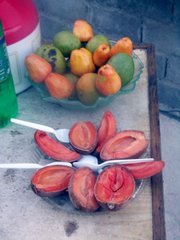By Garderner Jack
We had a mild winter this year and spring fruits should be abundant. We still have both sour and sweet oranges on the tree with the delicious Temple tangor soon to be ready and grapefruits waiting for perfection. Limes are scarce, so it is not a good time for making mojitos. There seems to be a brief lull in late March and April, then a whole host of fruit trees flower and begin production.
Dillies are already on the tree and heading towards ripeness. They grow in colonies in the bush, usually near the seashore, but the finest quality fruits are from selected cultivars. Sapodilla trees are tall and stately and their foliage with whorls of leaves is evergreen and handsome. I love many fruits but the one I just cannot stop eating when I have the chance is ripe, sweet dilly.
Some mulberry trees produce abundant fruit during the winter months but most varieties are spring producers. Mulberry fruits must be picked fully ripe and completely black. Any trace of red will give a sharp sour taste. A mulberry pie with slices of apple is a spring favourite in my house.
Cashew nuts come from the cashew apple tree and hang from the bottom of the fruit. Once the nut section is removed from the 'apple' the fruit can be enjoyed out of hand. The flavour is an acquired taste to some but others love it.
Much the same goes for wax jambu. The trees bear abundantly in late April and May, so much so that the bunches squeeze off most of the fruits and litter the ground. My trees tend to have an early crop that gives bright red fruits, then another heavier crop with pink fruits.
If you do not like wax jambu eaten out of hand you may enjoy it cooked in sugar water with a drop or two of red food colouring added. The fruit then tastes remarkably similar to lychee.
Later on in spring tamarind trees will start to bear their rather ugly pods. If you like sourness you can pull the pulp and seeds from the pod and eat the pulp as is. Soak the pulp and seeds in water for a few days then strain and sweeten and you have tamarind switcher, a refreshing drink. Boil the pulp and seeds with sugar and a little water and you get tamarind sauce, an irresistible concoction. Strain out the seeds and you have tamarind jam.
Surinam cherry trees are sporadic bearers but usually produce their first and heaviest harvest in spring. Some varieties of Surinam cherry have a somewhat fishy taste that is ameliorated by using the fruits for jam. The sweet black fruits are delicious out of hand and are admired not only for their taste but their beautiful scalloped shape.
The anonas will soon be flowering and some of them fruit in spring. Sugar apples are usually the first to bear and are almost always eaten out of hand. Soursops follow and set the stage for our national favourite - soursop ice cream.
Soursop fruits are destroyed when they fall and hit the ground so you may consider nestling the fruit in an onion bag or even a knotted section of tights leg attached to a branch so the fruit will not fall and be rendered useless.
Barbados cherry has its first production in spring and often gives a even heavier harvest in late August. The shrubs produce their fruits very quickly, going from flower to green fruit to ripe fruit in less than a fortnight. When you have too many to cope with you can make a fine cherry jelly. By using a food mill to process cherries boiled in sugar you create a lovely sauce for pouring over vanilla ice cream.
Late spring sees jaboticabas appear all over the branches and trunks of the trees. When many people see a fruiting jaboticaba for the first time they are stunned almost to disbelief. The round, black, slightly flattened fruits are juicy and grape-like. Some people detect a background flavour somewhat like condensed milk that is either appreciated or disliked, according to one's taste buds.
Spring will bring some fascinating fruits. Be sure to taste some.
gardenerjack@coralwave.com





Comments
Use the comment form below to begin a discussion about this content.
Sign in to comment
Or login with:
OpenID